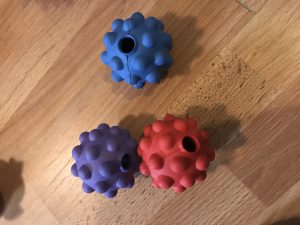
Lately, I’ve noticed that Joey’s speech increases significantly when we are playing ball. He will often request to play ball at random times during our lesson. Of course, I come to our sessions with plans, and rarely do those plans involve just playing ball. But, because the data shows that Joey is more talkative when we play ball, I keep letting us play in between our books and other activities.
So, during these “breaks” are Joey and I just relaxing or is he still working? What skills are involved with playing ball anyway?
To start, playing ball with another person requires that one must be attending to the other person. In order to throw a ball to someone and have them catch it, you must be using eye contact and verbal or non-verbal communication. Rolling a ball back and forth also follows our patterns of communication. Your turn while I wait and watch, then my turn. It cannot be played in isolation. I’ve written about Serve and Return here before, and playing ball is an excellent opportunity to engage in this type of back and forth interaction.

Ball play also involves hand-eye coordination and visual/spatial processing. This was never my strength when I was a child (which is evident if you ever watch me play softball), and it is not something I personally tend to think of as important. Yet, while we often overlook this skill in academic setting, it is important. The brain’s ability to recognize what the eyes see and then coordinate the hands to reach it is an essential skill, and is involved in everything we do, from our handwriting to sports. Even our self-care, or how we take care of our personal hygiene, relies on our hand-eye coordination.
When we are playing ball, Joey has to follow the ball with his eyes, and have his eyes, brain, and hands all work together to track and then capture the ball rolling toward him. He does not always get it, but he always tries. To pick up the ball, he has to coordinate his hand to hover over the ball, then open his fingers, move his hand closer to the ball, and then close his fingers at the right time without the ball slipping away. All of this takes practice, and coordinated brain effort.
After catching the ball, Joey has to transition his attention from the ball back to me. He either has to pass the ball back to me when I tell him to or, if the ball drops off his tray, he has to ask me to pick it up for him. For this, he will use his AAC device, and often selects the words ‘get’, ‘help’, ‘more’, or ‘need’ as a way to tell me he wants to keep playing.
To let me know he wants the ball, I ask him to say “go”. He does this orally (saying words with g’s are a strength for him.) He’ll watch me and the ball, and listen to me say, “1, 2, 3…” and then he says “Go, go, go!”
 Sometimes, I ask him how many balls he wants, so that he can use his AAC device and select a number. This helps him practice using the AAC device, respond to a question, and practice his number sense. If he says four, I’ll place four balls on his tray, and count each one. Lately he’s just been asking for one. Good choice – one is much easier to keep up with than four!
Sometimes, I ask him how many balls he wants, so that he can use his AAC device and select a number. This helps him practice using the AAC device, respond to a question, and practice his number sense. If he says four, I’ll place four balls on his tray, and count each one. Lately he’s just been asking for one. Good choice – one is much easier to keep up with than four!
What is more – all of the skills Joey is working on when he plays ball require a great deal of effort for him. While these skills get easier over time, the demands of asking for the ball, verbally saying “go”, catching the ball, rolling it back, and asking for the ball again require frequent shifts in Joey’s attention. He needs to transition his thoughts from the ball to me and back. All of this practice with shifting attention is important for his developing executive functioning skills.
Sometimes I get that guilty teacher voice in the back of my head that tells me I should do more than just play ball with Joey. Playing ball does not seem very teacherly. But in these moments of preferred play, Joey is working on so many skills at once, from visual/spatial processing, back and forth communication, communicating with the AAC, number sense, and shifting his cognitive focus.


